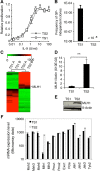Loss of mutL homolog-1 (MLH1) expression promotes acquisition of oncogenic and inhibitor-resistant point mutations in tyrosine kinases
- PMID: 27436342
- PMCID: PMC11108519
- DOI: 10.1007/s00018-016-2310-2
Loss of mutL homolog-1 (MLH1) expression promotes acquisition of oncogenic and inhibitor-resistant point mutations in tyrosine kinases
Abstract
Genomic instability drives cancer progression by promoting genetic abnormalities that allow for the multi-step clonal selection of cells with growth advantages. We previously reported that the IL-9-dependent TS1 cell line sequentially acquired activating substitutions in JAK1 and JAK3 upon successive selections for growth factor independent and JAK inhibitor-resistant cells, suggestive of a defect in mutation avoidance mechanisms. In the first part of this paper, we discovered that the gene encoding mutL homolog-1 (MLH1), a key component of the DNA mismatch repair system, is silenced by promoter methylation in TS1 cells. By means of stable ectopic expression and RNA interference methods, we showed that the high frequencies of growth factor-independent and inhibitor-resistant cells with activating JAK mutations can be attributed to the absence of MLH1 expression. In the second part of this paper, we confirm the clinical relevance of our findings by showing that chronic myeloid leukemia relapses upon ABL-targeted therapy correlated with a lower expression of MLH1 messenger RNA. Interestingly, the mutational profile observed in our TS1 model, characterized by a strong predominance of T:A>C:G transitions, was identical to the one described in the literature for primitive cells derived from chronic myeloid leukemia patients. Taken together, our observations demonstrate for the first time a causal relationship between MLH1-deficiency and incidence of oncogenic point mutations in tyrosine kinases driving cell transformation and acquired resistance to kinase-targeted cancer therapies.
Keywords: DNA mismatch repair; Drug resistance; Janus kinase (JAK); MLH1; Oncogenic mutations; Tyrosine kinase inhibitor.
Conflict of interest statement
The authors declare that they have no conflicts of interest with the contents of this article.
Figures







Similar articles
-
Bone marrow-derived mesenchymal stromal cells promote resistance to tyrosine kinase inhibitors in chronic myeloid leukemia via the IL-7/JAK1/STAT5 pathway.J Biol Chem. 2019 Aug 9;294(32):12167-12179. doi: 10.1074/jbc.RA119.008037. Epub 2019 Jun 24. J Biol Chem. 2019. PMID: 31235520 Free PMC article.
-
miR-217 sensitizes chronic myelogenous leukemia cells to tyrosine kinase inhibitors by targeting pro-oncogenic anterior gradient 2.Exp Hematol. 2018 Dec;68:80-88.e2. doi: 10.1016/j.exphem.2018.09.001. Epub 2018 Sep 5. Exp Hematol. 2018. PMID: 30195077
-
Loss of MLH1 sensitizes colon cancer cells to DNA-PKcs inhibitor KU60648.Mol Carcinog. 2017 Jul;56(7):1816-1824. doi: 10.1002/mc.22640. Epub 2017 Mar 10. Mol Carcinog. 2017. PMID: 28224663
-
Kinase-independent mechanisms of resistance of leukemia stem cells to tyrosine kinase inhibitors.Stem Cells Transl Med. 2014 Apr;3(4):405-15. doi: 10.5966/sctm.2012-0159. Epub 2014 Mar 5. Stem Cells Transl Med. 2014. PMID: 24598782 Free PMC article. Review.
-
Chronic Myeloid Leukemia in the Era of Tyrosine Kinase Inhibitors: An Evolving Paradigm of Molecularly Targeted Therapy.Mol Diagn Ther. 2016 Aug;20(4):315-33. doi: 10.1007/s40291-016-0208-1. Mol Diagn Ther. 2016. PMID: 27220498 Review.
Cited by
-
Unlocking Therapeutic Potential: Enhanced shRNA Delivery with Tat Peptide in the Human Respiratory Syncytial Virus Treatment.Adv Pharm Bull. 2024 Oct;14(3):696-704. doi: 10.34172/apb.2024.045. Epub 2024 May 14. Adv Pharm Bull. 2024. PMID: 39494251 Free PMC article.
-
Expression and prognostic significance of MLH1 and GPRC5C in resectable hepatocellular carcinoma.BMC Cancer. 2025 Jul 25;25(1):1215. doi: 10.1186/s12885-025-14591-1. BMC Cancer. 2025. PMID: 40713584 Free PMC article.
-
MLH1 Promoter Methylation and Prediction/Prognosis of Gastric Cancer: A Systematic Review and Meta and Bioinformatic Analysis.J Cancer. 2018 Apr 30;9(11):1932-1942. doi: 10.7150/jca.23284. eCollection 2018. J Cancer. 2018. PMID: 29896277 Free PMC article.
-
DNA Methylation in Radiation-Induced Carcinogenesis: Experimental Evidence and Clinical Perspectives.Crit Rev Oncog. 2018;23(1-2):1-11. doi: 10.1615/CritRevOncog.2018025687. Crit Rev Oncog. 2018. PMID: 29953365 Free PMC article. Review.
References
-
- Loeb LA. A mutator phenotype in cancer. Cancer Res. 2001;61(8):3230–3239. - PubMed
-
- Roche-Lestienne C, Soenen-Cornu V, Grardel-Duflos N, et al. Several types of mutations of the Abl gene can be found in chronic myeloid leukemia patients resistant to STI571, and they can pre-exist to the onset of treatment. Blood. 2002;100(3):1014–1018. doi: 10.1182/blood.V100.3.1014. - DOI - PubMed
Publication types
MeSH terms
Substances
LinkOut - more resources
Full Text Sources
Other Literature Sources
Research Materials
Miscellaneous

